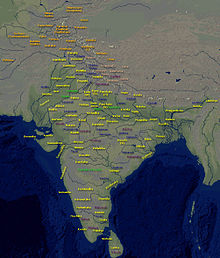| Revision as of 02:31, 29 February 2008 editEbizur (talk | contribs)Extended confirmed users13,185 editsmNo edit summary← Previous edit | Revision as of 12:20, 13 March 2008 edit undoGourangaUK (talk | contribs)8,602 edits →See also: Could these articles be merged?Next edit → | ||
| Line 12: | Line 12: | ||
| ==See also== | ==See also== | ||
| *] | |||
| *] | *] | ||
| *] | *] | ||
Revision as of 12:20, 13 March 2008

Nishadha (Sanskrit: निषाध niṣādha), Nishaad, or Nishad was an indigenous tribe inhabiting ancient India, according to sources in Hindu mythology. The Nishadha people have been described in Ramayana and Mahabharata.
Description in Ramayana
The main profession of Nishaads was hunting the birds. When a Nishaad had killed one bird from a pair, the other bird was crying, and that inspired Valmiki to write the true story of Rama and Sita known as Ramayana. In Ramayana, the king of Nishaad, named Guha, was a very close friend of Rama. He helps Rama and Sita to cross Ganges river.
Description in Mahabharata
The Mahabharata speaks of Nishaad (or Shabara) as forest hunters.
Music
In Indian music, Nishad is the seventh note (swara) of the octave.
See also
References
- Ramayana by Valmiki, Gita Press publication, Gorakhpur, India
- The Cultural Process in India by Irawati Karve, Vol. 51, Oct., 1951 (Oct., 1951), pp. 135-138
| Hindu deities and texts | ||
|---|---|---|
| Gods |  | |
| Goddesses | ||
| Other deities | ||
| Texts (list) | ||
This Hindu mythology–related article is a stub. You can help Misplaced Pages by expanding it. |